for the CREATIVE and CURIOUS

sounds creative
56


ENCYCLOPEDIA Volume R The UPPERCASE Encyclopedia of Inspiration encyclopediaofinspiration.com
FROM THE EDITOR’S DESK
Dear Reader,
The exuberant artwork on our cover is by Ali Barker, a painter with sound-colour synaesthesia, a phenomenon in which she sees certain colours when listening to music. The painting is Ali’s interpretation of “The Raiders March” by John Williams (theme song of the Indiana Jones movies!). Listening to music is a physical act with the artist’s interpretation dramatically recorded on canvas.

Audio links
Look for the audio link symbol next to content that has a sound or video component. You’ll find corresponding media listed by page number on the website: uppercasemagazine.com/56
Throughout this issue, we explore how sound and music—both their presence and their absence— influence our creative thinking. Sound can shape our visual art and inform our craft. Being in tune to the emotional qualities of music nurtures empathy. The challenge of playing an instrument teaches us patience, practice and perseverance. Composing music is an exercise in making intangible concepts audible. And, often, silence can be both welcome and glorious.
The essence of inspiration is paying attention to the world around us.
Listening is an art.
Janine Vangool PUBLISHER, EDITOR, DESIGNER
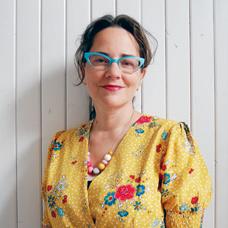
“Don’t disconnect the power,” my piano tells me after every session. Although it is referring to saving preferences into its digital memory, I read it as a creative mantra on the power of making music.
Sign up for my newsletter for free content and an introductory subscription offer: uppercasemagazine.com/free

uppercasemagazine.com ||| 3
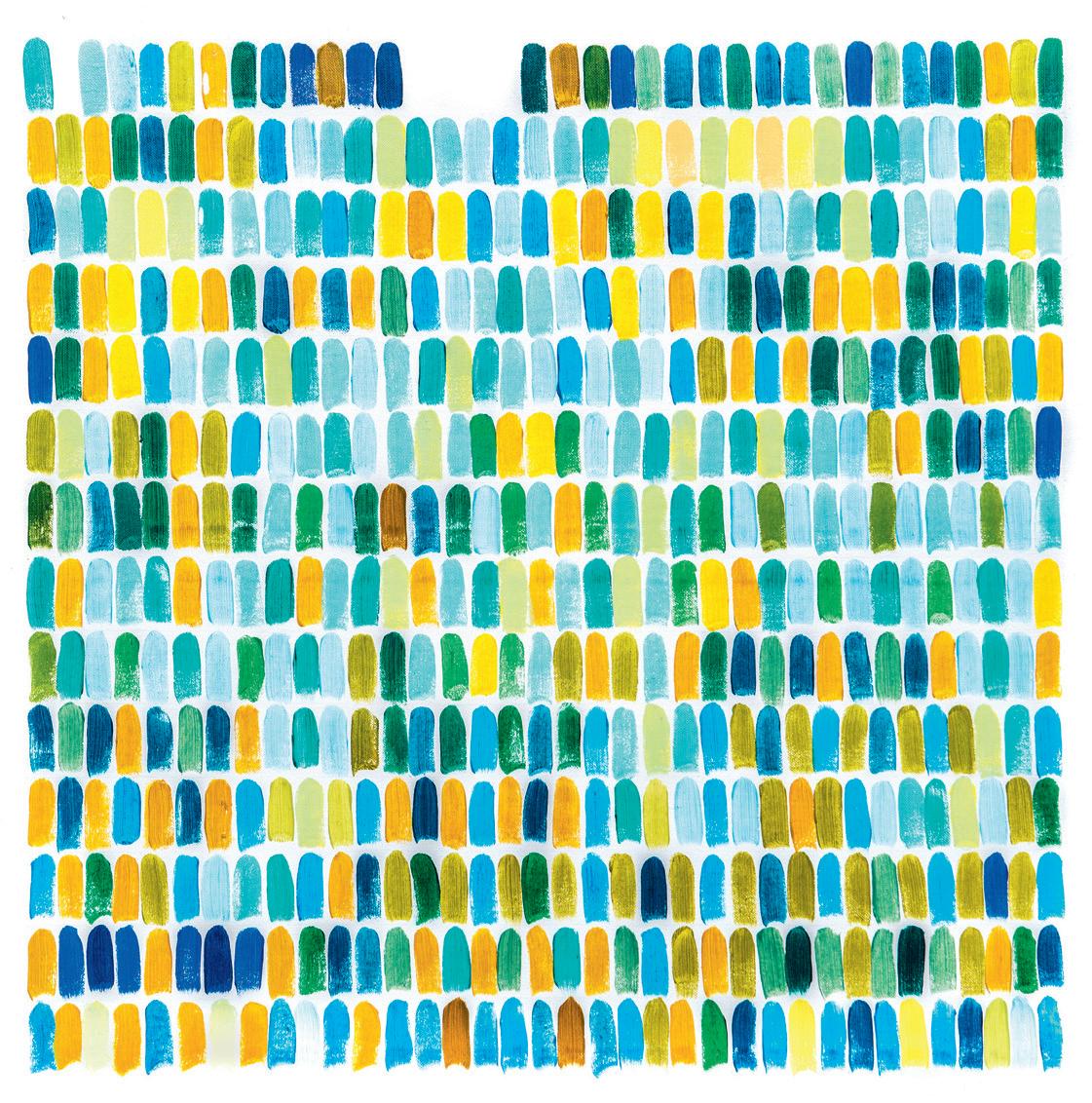
4 ||| UPPERCASE Contents
January / February / March 2023 “Bach Cello Suite No. 3 in C Major, Prelude”
Amy Kang amykang.com
Welcome
Editor’s Letter 3
Subscriptions 7
Contributors 8
Snippets . . . . . . . . . . . . 10
BEING 12
Listening to Yourself by Meera Lee Patel
FRESH . . . . . . . . . . . . 14
Bruna Pacheco Zoe Pappenheimer Wentian Tann Marvel Maring
CREATIVE CAREER 18 Dr. Sabine Waldmann-Brun
WORTHWHILE 19 Music Makes a Difference
Fine Print
LIBRARY 20 Recommended Reading
BUSINESS 22
Listening In by Arianne Foulks illustration by Andrea D’Aquino
MUSING . . . . . . . . . . . 24
Gravity Has a Sound: My Strange and Curious Marriage of Music with Painting by Cedric Victor
BEGINNINGS 26
Creativity and the Act of Listening: A Sound-Centred Approach to Getting Inspired by Thandiwe Shiphrah
EPHEMERA 32
Ephemeral Sounds by Mark E. Sackett & Melanie Roller
ORIGIN 38
Red Vinyl with a Red Label: Music Formats through the Years by Correy Baldwin
Art & Design
COVER ARTIST 44
Ali Barker: The Colour of Music by Jane Audas
PARTICIPATE . . . . . . . . 52 The Art of Music Submissions from Readers
TEA WITH T 66
Spilling the Tea with T: Performer Florence Mills by Tamisha Anthony
SKETCHBOOK 70
A Colourful Harmony: Musicians’ Sketches and Visual Compositions by Danielle Ridolfi
ABECEDARY . . . . . . . . 76 Creative Sounds by Lydie Raschka
ARTIST 78
Hélène Lindqvist: Singer, Painter, Multipassionate Artist by Andrea Marván
GALLERY 86
Look/Listen: Readers’ Creative Projects Inspired by Music and the Act of Listening
PERSPECTIVES . . . . . . 100
Quiet Time by Yanuary Navarro
PROCESS 102
An Invitation to Listen: Caitlind Brown & Wayne Garrett by Claire Dibble
ECO 108
Dissonant Stillness by Claire Dibble
Craft
CERAMICS . . . . . . . . . 112
Ceramic Sounds: Cecil Kemperink by Liz Logan
STITCH 120 Textiles and Sound
Misc.
HOBBY 124
The Sound of Silence by Brendan Harrison
Studio 126 Lela McKee Friel Maureen Fiorellini
Looking Forward 128 Shares . . . . . . . . . . . . . 129
COVET 130 Music Covers by Andrea Jenkins
You Ring My Bell
Felicia Dadak RENO, NEVADA, USA
I made this collage on an old 45 rpm record of a song called “You Ring My Bell.” I loved the challenge of working on a round substrate, especially one with a hole in the middle! Music is a very important part of my practice and I wanted to express the joy it brings with this work. Most of the paper I used for this collage is from vintage record sleeves from my collection.
@feliciadadak feliciadadak.com

uppercasemagazine.com ||| 5
BACK COVER
UPPERCASE
201B – 908, 17th Avenue SW
Calgary, Alberta, Canada T2T 0A3
Janine Vangool
PUBLISHER, EDITOR, DESIGNER janine@uppercasemagazine.com

CUSTOMER SERVICE shop@uppercasemagazine.com
Correy Baldwin COPYEDITOR
Core Contributors
Tamisha Anthony
Jane Audas
Correy Baldwin
Andrea D’Aquino
Arianne Foulks
Joy Vanides Deneen
Brendan Harrison
Andrea Jenkins
Andrea Marván
Kerrie More
Emily Orpin
Meera Lee Patel
Lydie Raschka
Lilla Rogers
Cedric Victor
PRINTED IN CANADA BY THE PROLIFIC GROUP.
Interior pages are printed on 100% post-consumer recycled Rolland Enviro 100.
Give this magazine a long life! The content is evergreen, so we hope you’ll revisit it over and over again. If you’re done with it, please pass it on to a friend or colleague who might enjoy our content, or cut up the pages and create some art.
SUBSCRIBE
SUBSCRIPTIONS
This quarterly magazine is released in January, April, July and October.
Prices shown in Canadian dollars. Our shop will do the currency conversion for you.
CANADA/USA $ 80
INTERNATIONAL
$ 120 RENEWALS
You will receive a notice by email when it is time to renew. Renew online anytime to add issues to your current subscription.
GIFTS
Simply enter the recipient’s name and address in the shipping information and your name, email and billing address during check out.
BACK ISSUES
Get them while you can! Once they’re gone, they’re gone. Back issues will not be reprinted. uppercasemagazine.com
STOCKISTS
To view our list of stockists or to carry UPPERCASE in your shop: uppercasemagazine.com/ stockists

uppercasemagazine.com
Thank you to all of the talented writers, illustrators, creative collaborators and loyal readers who contributed their talents to this issue of UPPERCASE.
Thank you to everyone who submitted to the open calls for this issue. Even if you weren’t featured within these printed pages, your effort was noticed and appreciated!
SUBMISSIONS
UPPERCASE welcomes everyone and all identities, ages, talents and abilities. We share an inclusive, positive and community-minded point of view. Everyone is welcome to explore our creative challenges and submit to the magazine—you don’t have to be a professional artist or writer.
treeera.com
QUESTIONS?
Have a question about your subscription or a change of address? Email us: shop@uppercasemagazine.com
Please visit the Participate page of our website for current open calls for submissions. The Fresh, Sketchbook, Creative Careers and Subscriber Studio columns are always open and submissions will be considered for print and for inclusion in All About YOU: the weekend UPPERCASE newsletter featuring creativity from readers around the world.
In the spirit of reconciliation, we acknowledge that we live, work and play on the traditional territories of the Blackfoot Confederacy (Siksika, Kainai, Piikani), the Tsuut’ina, the Îyâxe Nakoda Nations, the Métis Nation (Region 3) and all people who make their homes in the Treaty 7 region of Southern Alberta.
NEWSLETTER
Sign up for the newsletter to receive free content and behind-the-scenes peeks at the making of the magazine—plus a welcome discount on your subscription!
uppercasemagazine.com/free
You can also pitch your own work, propose an article about someone else or suggest a topic that you would like to research through the Open Pitch submisison form.
Please make sure that your submission is suitable for UPPERCASE magazine. Be familiar with the magazine and its writing and visual style.
uppercasemagazine.com/ participate
This independent magazine thrives because of you— its loyal subscribers!
We plant a tree with every subscription.
6 ||| UPPERCASE
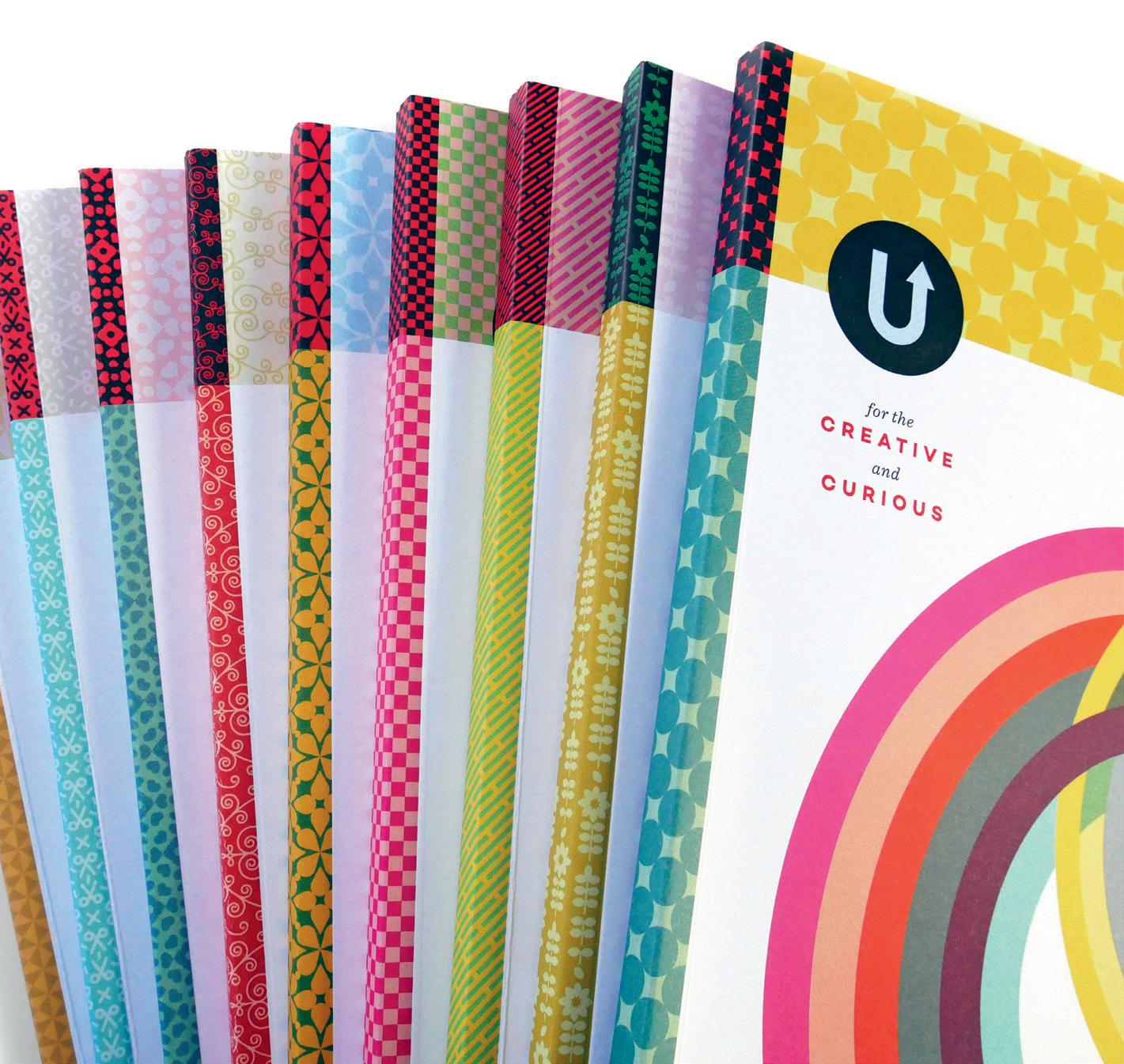

PUBLISHED INDEPENDENTLY SINCE 2009
™ ™
for the CREATIVE and CURIOUS
Subscribe!
How do you incorporate music into your life?
Liz Logan

Right now the main way I incorporate music into my life is enjoying— and often dancing to—the delightful scores of Disney films with my four-year-old daughter. Our favourites: Wall-E, Encanto, Moana, Frozen, Frozen II and The Little Mermaid. lizlogan.us




Tamisha Anthony
I have lived with anxiety the majority of my life and I have found that music plays an important role in my day-to-day. I have different playlists for writing, illustrating and even walking down the street (to give myself confidence!) and for public transit (to give myself peace). Since childhood, I have found that listening to strong, female vocalists can oftentimes release inner pain in the form of dance, tears or necessary self-talk. I use music to find understanding within and cope with sometimes seemingly simple tasks, so I can be free to run towards my dreams and master my goals.
tamishaanthony.com
Danielle Ridolfi
My favourite time to listen to music is after a long, stressful day. I play my favourite singable tunes in the car as I drive home, including some childhood favourites, and sing as loudly as possible. By the time I get home, I’m always smiling—it’s impossible to be stressed while you’re singing! danielleridolfi.com
Cedric Victor

On any given work day, I shift between listening to music and playing white noise in the background: the blocks of music are palate cleansers that bridge periods of focused work that the noise makes possible. Weekends have no such rules. specialorbits.com
Brendan Harrison
Meera Lee Patel

Andrea Jenkins
Music is as much a part of my daily life as coffee—I wouldn’t exactly die without it but I’d be very cranky. Whether I’m choosing what record to put on while I wash the dishes or teaching myself how to play a little something on the ukulele, it’s a glorious, essential constant.
andreacorronajenkins.com

Arianna Foulks
Music got me where I am today! My business journey was kicked off by writing, designing and editing my own indie music zine in the ’90s, which prepared me for two decades of entrepreneurship supporting creatives and artists.

aeolidia.com
I see music as a companion, a way to heighten whatever it is that I’m engaged in at the time: walking, painting, enjoying the breeze or having a wild dance party with my two year old. I’m in awe of a song’s simple ability to take me outside of myself—to take me somewhere higher, somewhere much more beautiful: beyond the limitations of conscious thought and rational thought. meeralee.com
When I was younger, I thought of music as the soundtrack of my life— I was always playing my favourite albums or heading out to watch live music. These days, music has become something I use to get into (or out of) certain types of moods… And it’s become more intimate and private, probably because my daughter can’t stand listening to what she calls my “sad country songs.”
brendanharrison.com

8 ||| UPPERCASE
CONTRIBUTORS
What instrument do you play?
Correy Baldwin
Janine Vangool
Andrea D’Aquino
Thandiwe Shiphrah

I play several hand percussion instruments and regularly collaborate with my husband, musician/ composer Daniel Arite, in an ongoing exploration of the interplay between word and sound.
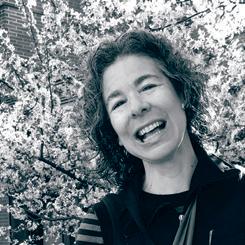




thandiweshiphrah.com
I play banjo, in what’s called clawhammer style. Old-time Appalachian stringband music has such a rich repertoire that is endlessly fun to explore. I’ve always had a soft spot for the banjo, and it felt like home when I finally picked one up. It can be haunting, but it can also get people dancing. correybaldwin.com
In high school, I played flute, alto, tenor and baritone saxophone and piano. Post-college, I was in a concept band, Advanced Funk Dungeon. We played a sold-out show (tickets were free) in the lead singer’s parents’ basement. Since getting a full-keyboard digital piano a year ago, playing has become a welcome part of my everyday. I’m challenging myself to learn various Chopin pieces that I thought would never be within my ability—they still might not be, but it’s fun to try!
uppercasemagazine.com

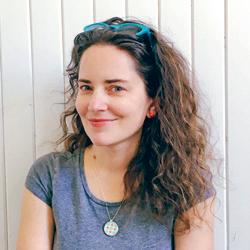
I’ll go with Revolver by the Beatles as a favourite album. A perfect mix of masterful songwriting that transcends time and genres. Sheer joy, melancholy, experimentation, psychedelia, humour, and rock and roll. Plus the album cover is a work of art (by a musician, Klaus Voormann) that incorporates collage in one iconic and forever modern image.
andreadaquino.com
Lydie Raschka
I learned to play violin in 4th grade. Here I am, violin in hand, off to my high school graduation. Playing in orchestras in high school and college gave me a sense of belonging and is where I made good friends—including my future husband over there in the viola section.

habitsofanartist.com
Claire Dibble
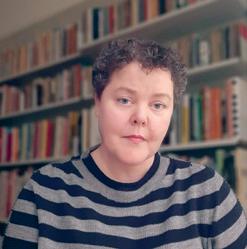
I haven’t played the bass guitar in years, and yet I’m still embarrassingly proud of winning an award for a bass solo in a high school jazz competition. The solo was the intro to “Goodbye Pork Pie Hat” by Charles Mingus, one of the greatest jazz bassists of all time. I’m not a bassist anymore, but I use every opportunity to tell people about my fleeting moment of jazz fame, including this brief bio. clairedibble.com
What’s your favourite album and why?
Jane Audas
Carrie and Lowell by Sufjan Stevens. I’m an album person. This one sits right with me if I’m happy or sad. It just melts in with my moods. janeaudas.com
Andrea Marván
When I’m writing I like listening to instrumental or classical music that helps me concentrate and opens my senses. I don’t have a huge repertoire; it’s usually the same few pieces over and over, but that helps it feel like a ritual and gets me into writing mode. However, when I’m taking photos or editing them, I like to listen to pop and upbeat songs to get some creative energy flowing.
mondegreen.ca
uppercasemagazine.com ||| 9
Snippets
EPHEMERA
Featured in Ephemera, Volume E of UPPERCASE’s Encyclopedia of Inspiration, collage artist Alison Stockmarr uses fodder from old books and collected papers to create dimensional record sleeve collages that are beautifully photographed and offered as limited-edition signed giclée prints. Ephemera was originally published in 2018, and the original print run has been sold out for a few years. Look inside this book and register your interest in a reprint on the UPPERCASE website.



uppercasemagazine.com/ephemera alisonstockmarr.com

10 ||| UPPERCASE
WISDOM
Nick Cave’s The Red Hand Files

Musician Nick Cave’s The Red Hand Files is an unexpected and brilliant newsletter. He prefaces each missive with questions from his fans—combining related and unrelated questions—from which he riffs ideas and anecdotes about music, muses, grief and creativity.

Q Are there times your creativity disappears and if so how do you coax it back / jump start it?
A Creativity is not something that can disappear. The creative impulse is simply the strategy used to catch ideas. Ideas are everywhere and forever available, provided you are prepared to accept them. This takes a certain responsibility to the artistic process. There is discipline and rigour and preparation involved. You must prove yourself worthy of the idea.
Read more of Nick Cave’s answers in The Red Hand Files. theredhandfiles.com
Sharing smiles by making paper goods sing

Sharon
Glassman HYGIENE, COLORADO, USA
“If only we could take you home and put you on the wall so we could hear your happy songs and see the sunny vibes you create!”
This request from a fan at one of my live music shows inspired me to create my Smile Songs line of musical greeting cards and gifts. Each singing card, sticker and wall art print celebrates your best self in a super fun, meaningful way—which makes folks of all ages literally jump for joy. I handcraft original songs for each design to amplify their good feels, which delights the senses. Use QR codes to play them from the art, turning smartphones into modern music boxes.

@smile_songs smilesongs.com

Positive Interactions: an album of happy sounds by Tommy Perman

“Making music and keeping in touch with friends makes me happy,” says Scottish artist Tommy Perman. In September 2020, he reached out to friends around the world and asked them to send him sounds that made them happy. “The contributors span a wide age range: from toddlers to people who are well into adulthood. Through their sounds and messages I was reminded of the different things sound and music can mean to us—a toddler intently exploring sounds of a xylophone with her dad, ‘grown-ups’ revelling in losing themselves while making music.” Recordings of birdsong, nature, children, pets and sonic tidbits from other musicians are threaded with melodies and percussion, resulting in 20 immersive tracks. “I want to share this album with as many people as I can,” says Tommy. “Rather than ask for money, I thought it was a nice idea to encourage some happy thoughts. So if you would like to ‘buy’ the album simply email a message about something that makes you happy to happy@positiveinteractions.space and you’ll receive a download link.”
positiveinteractions.space
uppercasemagazine.com ||| 11
PAPER GOODS
THIS IS A LOW RES PREVIEW OF A HIGH QUALITY QUARTERLY PRINT MAGAZINE PLEASE SUBSCRIBE
ALBUM
listening to yourself

12 ||| UPPERCASE
BEING

THIS IS A LOW RES PREVIEW OF A HIGH QUALITY QUARTERLY PRINT MAGAZINE PLEASE SUBSCRIBE

WHETHER YOU’RE A FRESH GRADUATE OR MATURE ARTIST, IT IS OFTEN A DREAM TO BE PUBLISHED FOR THE FIRST TIME! You’re welcome to submit your work for consideration. uppercasemagazine.com/participate
FRESH
fresh talent
Bruna Pacheco
Hello, my name is Bruna and I am a Brazilian print designer and illustrator based in London. In my work I like to explore the universe of childhood and children’s imagination, creating a colourful world for big and small people. Having spent 18 years working in the fields of marketing and advertising, I became a freelance artist after the birth of my son. It was then that I reconnected with my creativity, with my passion for drawing and telling stories through illustration. My inspiration comes from fashion, fine art, literature and the time spent with my family. I work digitally, in gouache, watercolours, and pen and ink. We were all children once. That’s what I want my art to evoke: the creativity, joy, imagination and playfulness that we all have within ourselves. I would love to see my illustrations being hung in children’s bedrooms and I also would love to develop a bright and fun kidswear collection.


@bruna_illustra brunaillustra.com
Hello Paper Dolls started from a love of imaginative fashion and a desire to play dress-up. Creating my own clothes and my own models allowed me to play with gender fluidity and body positivity. I would love for these dolls to spark joy in others the way they do in me.


@hello_paper_dolls hellopaperdolls.com

uppercasemagazine.com ||| 15
LONDON, UNITED KINGDOM
Zoe Pappenheimer
NORTHAMPTON, MASSACHUSETTS, USA


THIS IS A LOW RES PREVIEW OF A HIGH QUALITY QUARTERLY PRINT MAGAZINE PLEASE SUBSCRIBE


musical creativity

20 ||| UPPERCASE
RECOMMENDED READING BY janine vangool


THIS IS A LOW RES PREVIEW OF A HIGH QUALITY QUARTERLY PRINT MAGAZINE PLEASE SUBSCRIBE

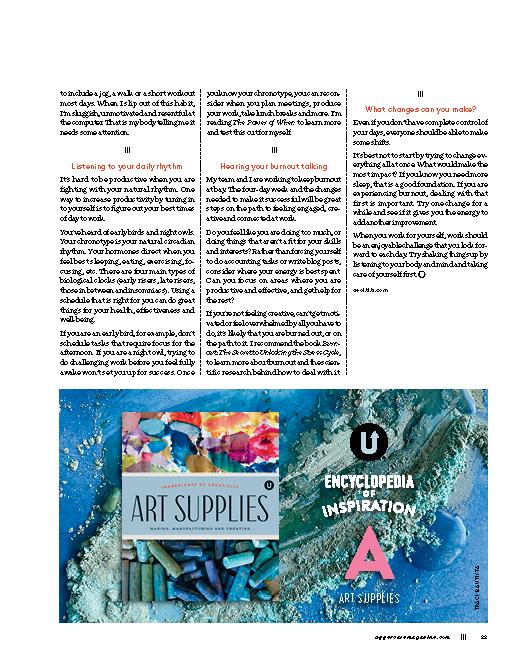



creativity and the act of listening
A SOUND-CENTRED APPROACH TO GETTING INSPIRED
TEXT AND ART BY thandiwe shiphrah ||| leafy arm beckons red bird completes a flight wind echoes delight |||


Paying attention
We head out around 8am. The destination: our favourite trail at Radnor Lake State Park, a nature preserve located a few miles away from the centre of the city. If we arrive at the right time, we might catch sight of a blue heron or a family of deer. Once or twice a month, I take a long walk and have a nourishing conversation with one of my closest friends. We both enjoy being in nature and a walk around the lake is a good way to connect with ourselves and stay in touch with each other. By 10am we are nearly finished our mutual updates on work and family and have reached the point on the trail that captivates me the most. “This place is so beautiful!” I exclaim (almost every time). This time we accept the invitation of an empty wooden bench and bask in that expansive tableau of greenery. The longer we sit, the longer I want to stay there. Before leaving, we take a few extra minutes to listen with our eyes closed and then a few minutes more to write in our personal journals.
When I return from one of our walks or when I take an extended nature retreat, I revisit my journals to reflect on what I saw and heard. I look for words and phrases that reveal what I thought or felt in the moment and often I will underline those with sound patterns that please my ear. Later, the underlined entries will prompt me to start a painting, a story or a poem. |||
IN CONCERT
A mile and a half into the woods: a flute-like joy

Sustained by birds that sail by Never letting their zeal subside I left my camera at home in its case I wanted to look with bare eyes, to listen As far and as much as I could To water To wind
To the gnarled veins of an uprooted tree I’m certain I heard before I saw Mimus polyglottos singing in many tongues
She seemed to be improvising leaps and runs This vocalist with astonishing range Charmed me with her repertoire
Her meadowlark and raven’s call Made language that I understood Revealing a most fervent wish To lift and perch
To dazzle air with the certainty of my birth The fullness of my name And then the mockingbird drew near But she didn’t have to hover long A woman passing by me said “Bear witness
As you hearken for your song”
uppercasemagazine.com ||| 27 BEGINNINGS
|||||||||||||||||||||||||

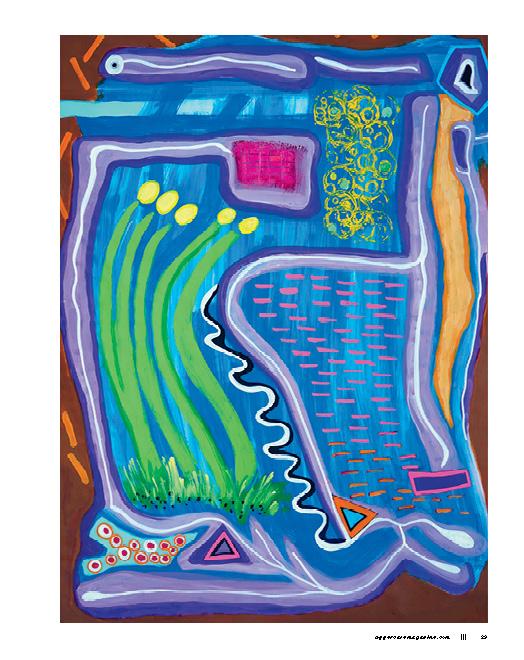
THIS IS A LOW RES PREVIEW OF A HIGH QUALITY QUARTERLY PRINT MAGAZINE PLEASE SUBSCRIBE

 ARTICLE BY mark e. sackett AND melanie roller
ARTICLE BY mark e. sackett AND melanie roller
ephemeral sounds
If you are a frequent visitor of antique stores, chances are you have encountered a pile of dusty paper sheet music more than once. Mass produced and sold in large quantities from the mid-1800s to the early 1900s and beyond, sheet music is one of the most common forms of surviving paper ephemera. The term “sheet music” itself refers to the combination of music notation and text (lyrics) printed together in a short paper folio. The sheet music publishing business was once a booming, robust, multi-million dollar industry marketed to people of all walks of life.

In addition to providing entertainment value during times with much fewer diversions, playing a piece of music also brought people together and created community through the enjoyment of song. Groups would gather around organs and pianos strewn with newly purchased paper scores to hear and perform the latest popular tunes. Sheet music publishing created a visual record of the pop culture of the time. Through bright, graphic covers, the trends, preferences and social history of the turn of the century were reflected, making the medium a valuable record for social historians, designers and students of history alike.

32 ||| UPPERCASE EPHEMERA





34 ||| UPPERCASE

THIS IS A LOW RES PREVIEW OF A HIGH QUALITY QUARTERLY PRINT MAGAZINE PLEASE SUBSCRIBE



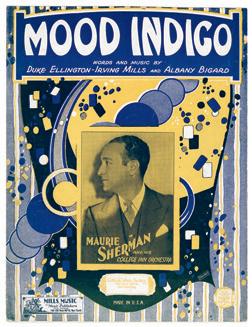


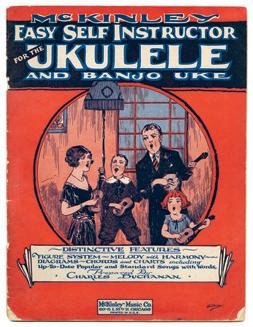






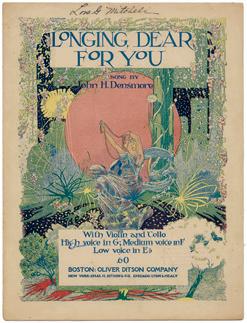


36 ||| UPPERCASE
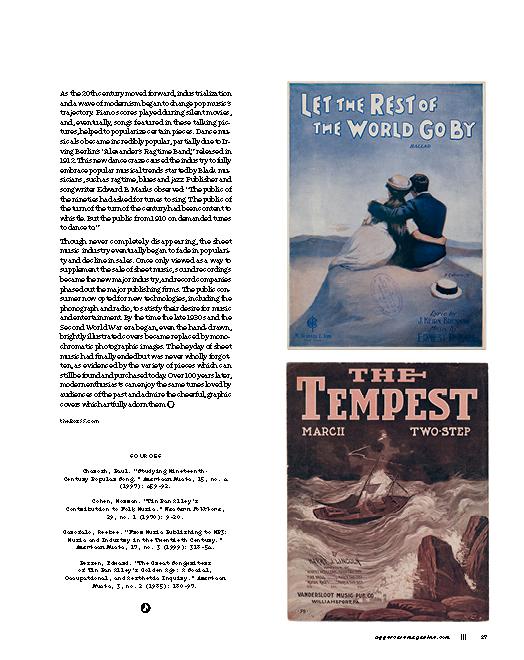
red vinyl with a red label

 BY correy baldwin
BY correy baldwin


38 ||| UPPERCASE ORIGIN
MUSIC FORMATS THROUGH THE YEARS ||| STORY
Thomas Edison and an early version of his phonograph, April 1878.
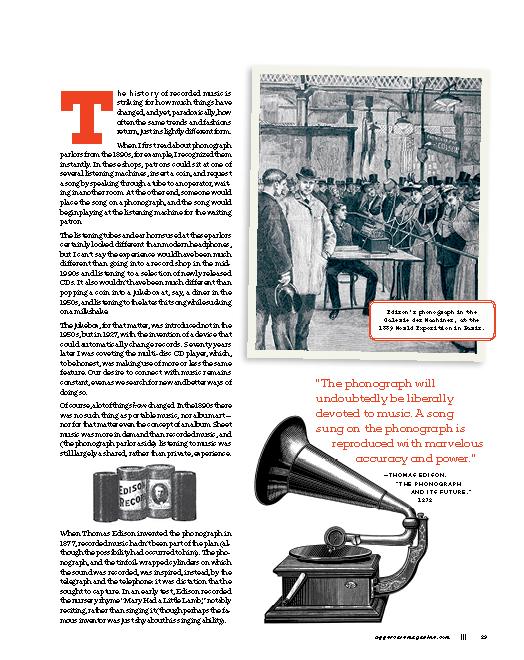
The gramophone came along in 1893, a device that played flat discs rather than cylinders. Both discs and cylinders were used into the 1920s, though in the end the disc, which could be more easily mass-produced, won out.
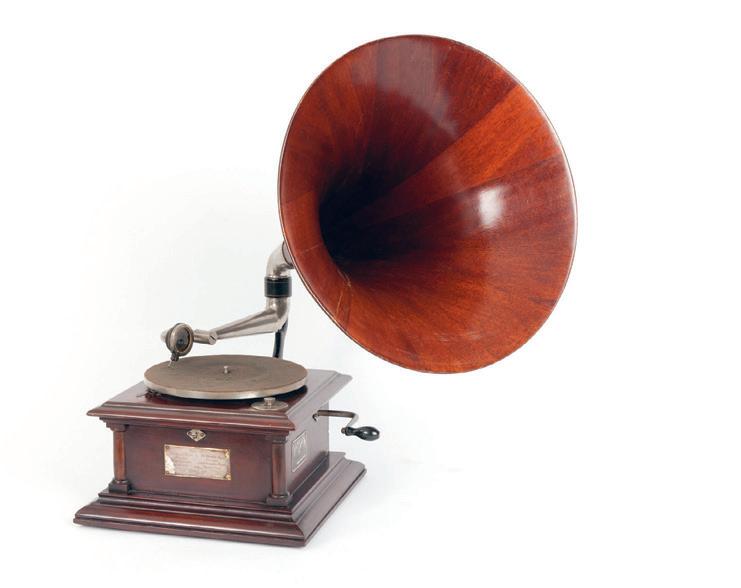
Despite these inventions, recorded music remained something of a novelty for a stubbornly long time. Music was still regarded as something meant to be performed, live and in person. If someone liked a song, they wanted to play it themselves: it wasn’t recordings that music fans were snapping up, it was sheet music.
Recordings were, at first, just another way to promote sheet music sales. Still, the growth of the recorded music industry caused a lot of consternation among songwriters, who earned much of their living through royalties of purchased sheet music. It also worried performing musicians, who had legitimate concerns about being replaced. Composer and conductor John Philip Sousa—who in 1909 fought for and won copyright laws guaranteeing royalties for recorded music— once wrote that bringing “canned music” to a campfire was “a thought as unhappy and incongruous as canned salmon by a trout brook.”
But if there was a threat, it wasn’t imminent. Phonographs were awkward technology: they had to be manually cranked with each use, cylinders could only play for two or three minutes, and the material that discs were made from, shellac, was brittle and scratched easily. They also had to contend with the immense popularity of radio, with its variety shows and live music. Radios were even fitted with electric speakers, which sounded far better than the massive brass bell horns used on phonographs.
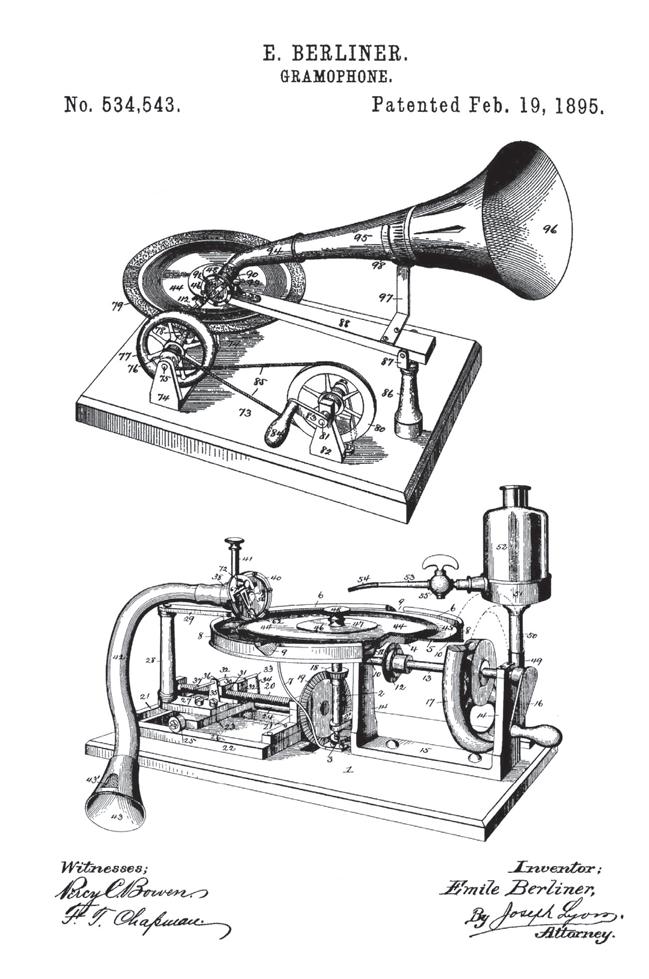
Phonographs had some catching up to do. They became electric, more affordable, less cumbersome. They also became more beautiful. In 1906 the Victor company introduced the Victrola, a phonograph housed within a tall wooden cabinet: music as sophisticated furniture. In 1948, Columbia Records finally ditched the fragile shellac, and produced a disc made out of polyvinyl chloride (or “vinyl”), a plastic that was lighter, stronger and more durable. Even more significantly, vinyl allowed the grooves in a disc to be cut closer together, allowing for more recording time: up to 23 minutes per side. Columbia had just introduced the world to the vinyl “long play,” or LP.
The following year, RCA introduced its own innovation: a smaller, seven-inch vinyl record, playing six minutes per side. (These became known as “45s,” because they ran at 45 rpms, or rotations per minute; LPs, or “33s,” ran at 33 1/3 rpms. The old shellac records were “78s.”)
But why the need for both a long play and a short play?
40 ||| UPPERCASE
The patent of Emile Berliner’s gramophone, February 19, 1895.

ample. Technically titled The Beatles, it will forever be known by the description of its album packaging: it is the “White Album.”
The Rolling Stones were perhaps more juvenile, though arguably no less inventive, with their 1971 album, Sticky Fingers. The album cover featured a closeup of a man’s crotch, wearing jeans. An actual zipper was attached to the cover, and unzipping it revealed the man’s underwear. Tee hee.
Just as important as album covers was the growing focus on portability. People wanted to move their music from place to place. Record players became smaller and lighter, and the company KLH even created a portable record player set into an actual suitcase, complete with detachable side speakers.
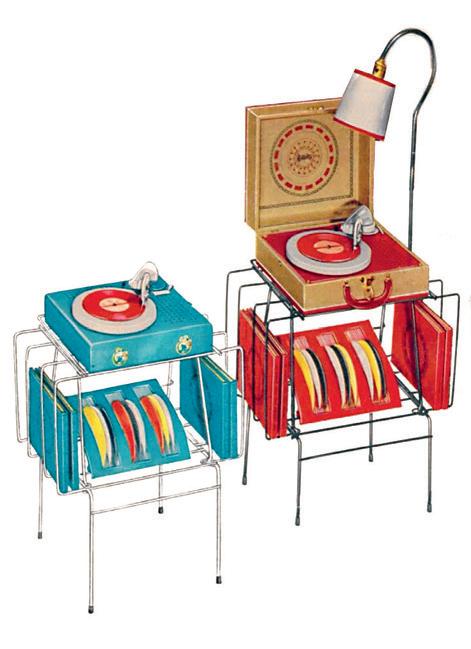
The most challenging frontier was the car. In 1956, Chrysler began installing a record player in their vehicles, known as the “Highway Hi-Fi.” Although it remained a novelty (it worked better than you might think, but was no match for potholes), it whet the appetite for more road-worthy formats.
The first of these came in 1965, when Ford introduced the 8-track, a compact plastic cartridge that made use of the magnetic tape technology of reel-to-reels. The 8-track was a curious invention. It could play continuously, without having to be flipped over, but it couldn’t rewind. Instead, songs were grouped into four “programs,” which you could skip ahead to, rather than skipping individual songs. Although its domain was the car, both home and portable 8-track stereos were made. It was the first time an album could properly be brought with you, wherever you went.

The 8-track was poorly made, and finicky, and was eventually replaced by its superior rival, the compact cassette tape. Tapes were even smaller, and they could rewind. When Sony launched its “personal cassette player,” the Walkman, in 1979, portable music had finally found its groove. It was also the era of the “boombox,” the portable stereo that became synonymous with urban street culture, and the new hip hop in particular (earning it the nickname the “ghetto blaster”).
FLEXI DISC
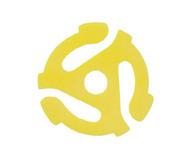

For a brief time, there was something called a “flexi disc,” a record pressed into a thin, square sheet of flexible vinyl—often inserted into magazines as promotional material, or within music instructional books. The Beatles gave away special Christmas recordings on flexi disc to their fan club, from 1963 to 1969. Flexi discs were so light that there was often a spot printed on the disc where you could place a coin to weigh it down.

42 ||| UPPERCASE
“In my mind and in my car We can’t rewind, we’ve gone too far”
—THE BUGGLES, “VIDEO KILLED THE RADIO STAR,” POSSIBLY LAMENTING THE 8-TRACK
Refer to alexsteinweiss.com for an archive of album cover designs or the book published by Taschen in 2015.

THIS IS A LOW RES PREVIEW OF A HIGH QUALITY QUARTERLY PRINT MAGAZINE PLEASE SUBSCRIBE
Art & Design

44 ||| UPPERCASE
“Sibelius Violin Concerto, 1st movement (Synaesthesia 168)”
uppercasemagazine.com/56
Audio links
Ali Barker, our cover artist, experiences sound-colour synaesthesia, which means she can experience sounds as colours. Whilst painting our cover, Ali was listening to “The Raiders March” by John Williams—the theme from the Indiana Jones movies. “What I ‘see’ is difficult to put into words (many synaesthetes find it difficult to describe their experiences) but could be described as fleeting perceptions of bright colours in my mind’s eye,” she says. “It is not a learned response, or a metaphor for describing something.” Of course, you don’t need to know that Ali experiences synaesthesia to appreciate her work. But knowing about her synaesthesia makes you go back to her work, again and again. “I don’t consider my synaesthesia to be a ‘condition’; for me, it is an ‘addition’ to my everyday life.”

Ali wasn’t always aware there was a name for her synaesthesitic experiences. As a child she learned to keep quiet about it. “I have had synaesthesia for as long as I can remember—though, initially, I didn’t realize others didn’t ‘see’ the same things as me. Growing up in the late 1970s and early 1980s, before widespread knowledge of synaesthesia, I was laughed at when I talked about notes being seen as colours. So, like many other synaesthetes, I stopped talking about it and hid it, even from family and friends. I never understood it as a child, but I now realize that much of the research into synaesthesia has been done since I left school.”
Ali grew up in Sheffield, in the north of England, in a musical family. Both her parents sang in choirs in their spare time, and as a child she learned to read music and play the violin. She plays the violin (and viola) still, mainly in orchestras, as a hobby. “My artistic journey was a little unconventional, as I didn’t study art at school,” she says. “I had to choose either art or music to fit in with three science subjects, so I chose music! My first degree and career were science based, but, in my spare time, I continued to make some artwork and visit galleries and exhibitions, as well as play in local orchestras.” She moved to Liverpool in 1995 (and she still lives nearby) for her first graduate job—and because her husband is from the city.
In 2009 Ali decided to go back and study A-level (advanced level) art part-time and to begin to explore her (postponed) interest in the connections between music and art. A few years later she decided to focus on
ali barker the colour of music
TEXT BY jane audas
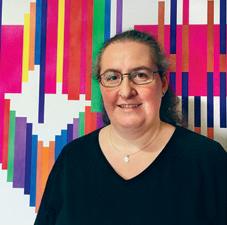
uppercasemagazine.com ||| 45 COVER ARTIST




Synaesthesia

One of the key researchers into synaesthesia, the American neurologist Richard E. Cytowic, notes in his 2018 book, Synesthesia, that there are over 150 types of synaesthesia that have been reported so far. Sound-colour synaesthesia, which Ali experiences, is one of the most common types. Synaesthesia has been defined as joined, or coupled sensations, or the stimulation of one sense producing a sensation in another sense.

Ali explains more: “Although I don’t perceive colours all the time, when I do, they are always the same: very specific colours for notes of the musical scale, appearing in my mind’s eye when I listen to music.” Ali’s interest in researching the connections between music and art was sparked by a painting by Wassily Kandinsky (also believed to have been a synaesthete). He painted “Impression III (Concert)” in 1911 as his response to listening to a concert of new music by the composer Arnold Schoenberg. It helped Ali to understand that her experiences might be synaesthesia: “I began putting down the colours I perceived in paint and to define my musical colour scale. I frequently apply colour to a white background, as I interpret white as an absence of sound; when I use a sequence of colours to represent a melody, white represents rests or gaps in the music. The colours I perceive are always the same for specific notes of the musical scale and they are the starting point for my artworks.”
Synaesthesia is something you may or may not know about Ali’s practice when you see her work. But she puts it front and forward when talking about it: “Despite the apparent prevalence of synaesthesia, relatively few contemporary artists say they are synaesthetes when talking about their work; even fewer state that they knowingly use it in their practice. It is my choice to make it clear that it is an important, personal aspect that I bring to my work, and a driving force for the work.”
50 ||| UPPERCASE
“Bach: Toccata and Fugue in D minor – Fugue (Synaesthesia 110)”
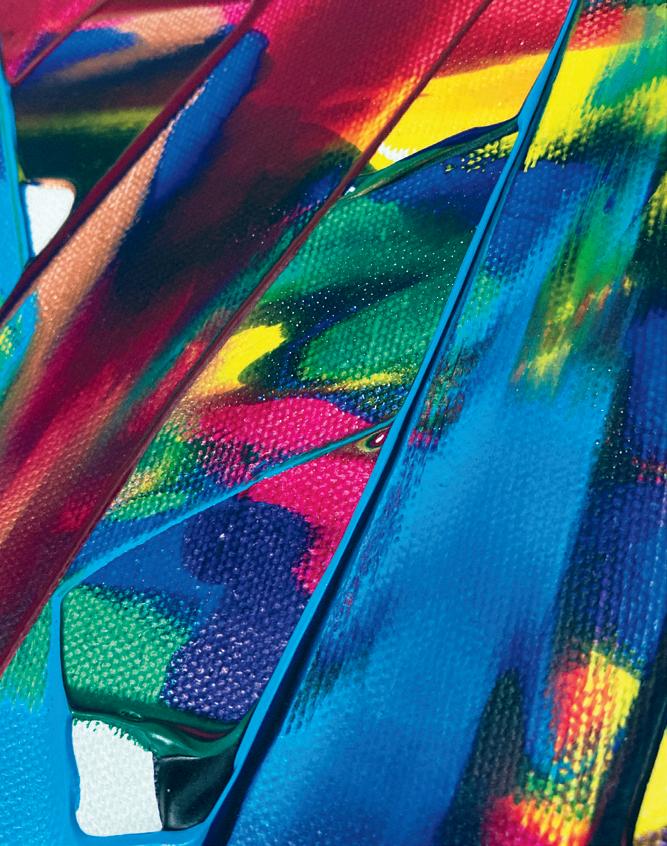



 “Theodorakis: Zorba the Greek (Synaesthesia 221)”
“South Pacific: Some Enchanted Evening (Synaesthesia 227) [after Rodgers and Hammerstein]”
“Theodorakis: Zorba the Greek (Synaesthesia 221)”
“South Pacific: Some Enchanted Evening (Synaesthesia 227) [after Rodgers and Hammerstein]”








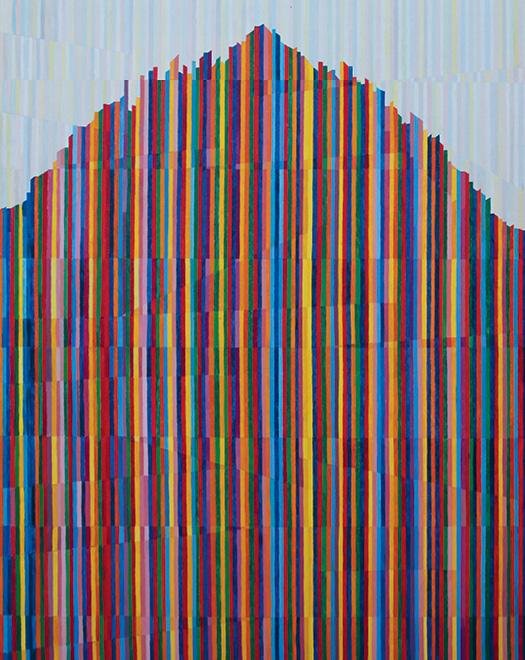















Aria
Meaning “song” or “melody” in Italian; a solo vocal piece.
creative sounds
COMPILED AND WRITTEN BY lydie raschka
Concertina

A musical instrument with a folding middle part that is played like an accordion. The word means to fold, crush or push together.
Birdsong
The song of one or more birds has often been the inspiration for composers over the centuries.

LEidophone
Welsh singer Margaret Watts Hughes invented this device to measure the power of her voice. It grew into an exploration of flower-like, geometric forms created through the interaction of voice, instrument and materials.

Guido d’Arezzo
Do-Re-Mi
Refers to solfège, a system of learning musical scales (dore-mi-fa-sol-la-ti), and the title of a song from the 1965 film The Sound of Music

Fermata
A symbol used in sheet music to indicate that a note should be held longer than its standard duration.


Impressionism
In music and art, a term that imparts a sense of veiled, blurred images and a rich sound or palette.
An Italian Benedictine monk born around 991, who created what is now considered the standard music staff.

Jelly Roll Morton
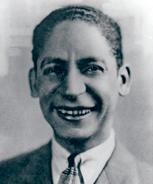

Hydraulophone

A tonal acoustic instrument that uses a constant stream of water and the player’s hands to make sounds with varying pitches.

Key
The relation of different chords to each other, as in the key of G major. In visual art, high key denotes light values and low key denotes dark values.
An American ragtime and jazz pianist, bandleader and composer, who said, “Jazz is to be played sweet, soft, plenty rhythm.”
76 ||| UPPERCASE ABECEDARY
PUBLICDOMAINREVIEW.ORG



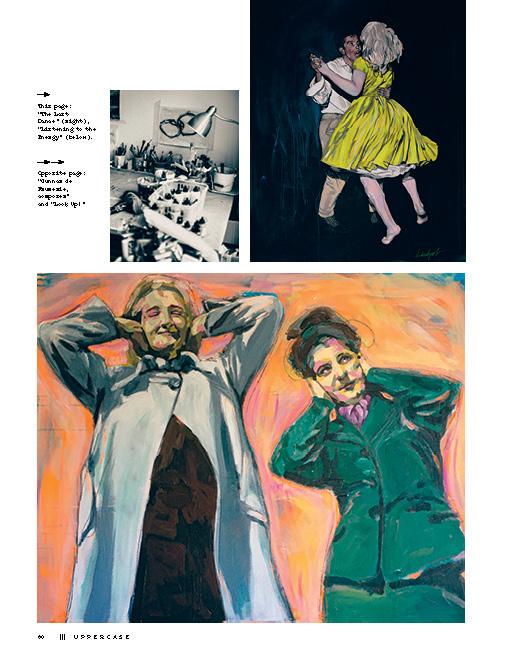



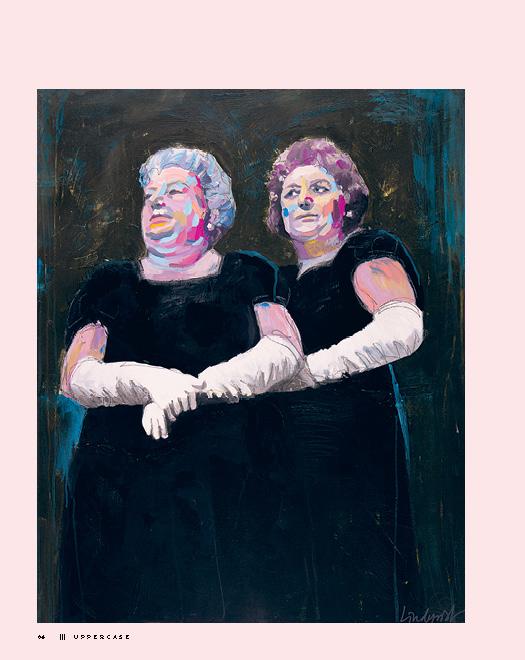

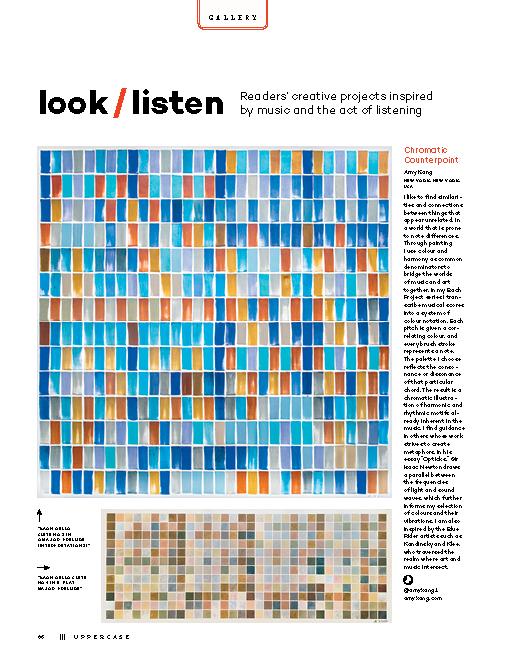

Beauty Heals
Linda Worster & Paulene Hübsch STUTTGART, BADEN-WÜRTTEMBERG, GERMANY
Art has always been a great instrument to deal with loss for me. Lately I was sitting with a wonderful friend of mine and we were talking about the latest school shooting in the US. Linda Worster told me that she had started to write a song, to process this heartbreaking massacre. She played what she already had written. Listening to this beautiful song touched my own heartbreak, when I lost my son years ago.

Immediately I had these pictures in front of me and felt this deep compassion with all the parents who lost their child. The song transmitted all the pain Linda felt, because of all these tragedies. At the same time it soothed her, and my heart. We had the idea to make a project together. She would develop the song and I would create an animation for it. These pictures are the beginning of the project, as her text is. Hopefully it speaks to everyone who needs some beauty in their life.
ILLUSTRATIONS BY PAULENE HÜBSCH @paulenes_world paulenehuebsch.com

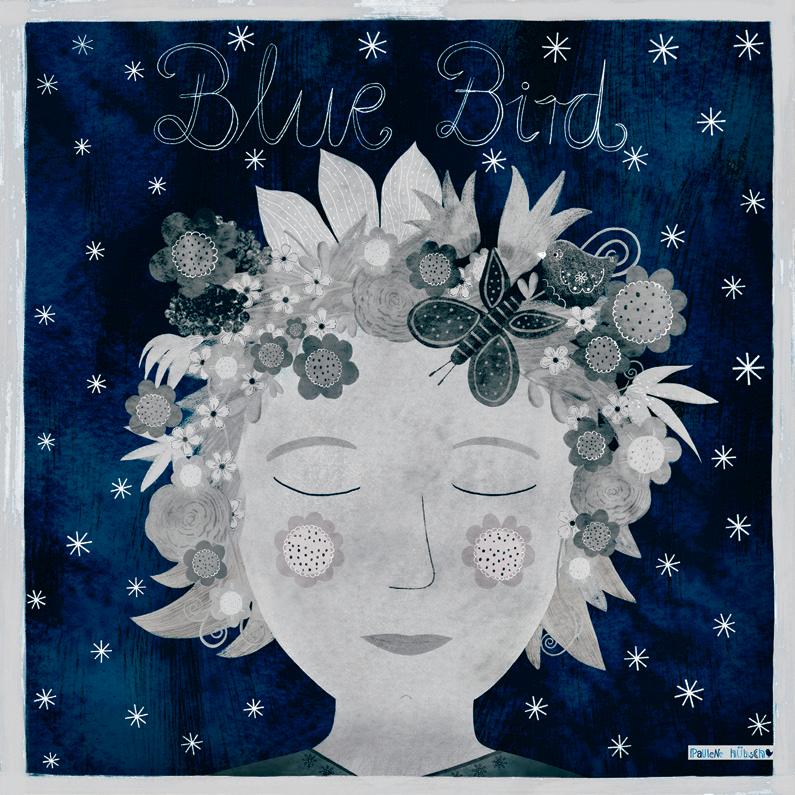
88 ||| UPPERCASE
bluebird I need your beauty today on this sad, sad day when I can’t stop crying bluebird bluebird I need that colour to touch this broken heart take me flying bluebird LYRICS BY LINDA WORSTER lindaworster.com

Jazz
Lloyd Pollard
ONTARIO, CANADA
TORONTO,
This image is the cover of a book called Jazz (September 2022). It is inspired by the attitude and multifaceted, intuitive nature of jazz. This book is visual jazz without the stereotypical symbolic imagery that is the staple of jazz.

@kasp74_pollard lloydpollardart. squarespace.com
MC’s music
Mark A. Conahan
PORTLAND, OREGON, USA
Who has just one favourite song? I’ve done several song-related calligraphy/bookbinding projects in the last couple of years. I wrote out the lyrics to the Beastie Boys album Paul’s Boutique, each song in a different style, and bound it as a 9 by 12-inch codex. I just finished writing the lyrics from the Sex Pistols’ Never Mind the Bollocks as an old blackletter hymnal-style at 13 by 20 inches and did smaller books of “Can’t Hurry Love” by the Supremes (6.5 by 10 inches), “Anthrax” by Gang of Four as two overlapping texts because the song has overlapping vocal lines (5 by 6.5 inches) and Patti Smith’s “Babelogue” (6 by 9 inches) in an accordion fold. It’s funny to realize how much songrelated work I’ve done.

antigravitypress.com
Patti Smith: A short diary

Isabella Fabris BOLZANO, SUDTIROLO, ITALY
A small tribute to a great woman, songwriter, poet and musician. My illustrations for the project are based on three colours on 20 pages, on text by Renato Sclaunich for Edizioni Scarabocchio.
@isabella_fabris_ isabellafabris.blogspot.it
90 ||| UPPERCASE

THIS IS A LOW RES PREVIEW OF A HIGH QUALITY QUARTERLY PRINT MAGAZINE PLEASE SUBSCRIBE
Otis Laboratory Press LOS ANGELES, CALIFORNIA, USA
In celebration of Black History Month, Otis Laboratory Press has created a limited-edition letterpress poster set to celebrate Black music artists of yesteryear and today. The music of these artists impacts and influences the music industry and affects many of our lives. This poster set is a thank you for sharing your gift, paving the way and speaking your truths through sound and lyrics. The six letterpress poster sets are designed and printed by the artists and staff of Otis Laboratory Press.

@otislabpress
Harmonic Resonance




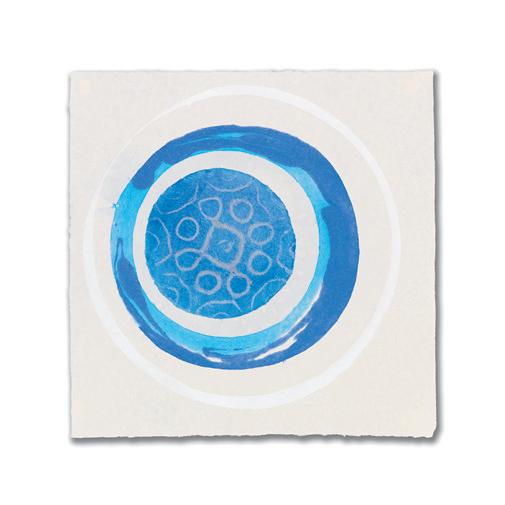 Pamela J. Paulsrud WILMETTE, ILLINOIS, USA
Pamela J. Paulsrud WILMETTE, ILLINOIS, USA

When I began papermaking years ago it was for the purpose of examining and exploring the creative process from inception to completion. The medium became an art unto itself: sheet formation with pulp painting, paper casting, sculpture and installations. The incredible versatility through fibre and additive choices, beating times and formation techniques added to the possibilities of using paper as a means of expression—and eventually a vehicle for capturing the mark of sound and resonance in paper with cymatics. Cymatics is the study of the visible effects of sound and vibration. I was fascinated by the physics experiment in which sand scattered across a metal plate is vibrated with sound frequencies, shifting the sand into mandala-like formations. With each frequency change to the plate, chaos ensued, and then another form reminiscent of sacred geometry appeared—each formation more complex as the frequency heightened. In “Harmonic Resonance” the visual beauty of the geometric patterns portray the responsiveness of matter to sound and illuminate the poetic and philosophical principles of nature— including chaos as the instrument of change.
pamelapaulsrud.com
92 ||| UPPERCASE
For the Love of Music: a letterpress celebration of Black music artists
ALRIGHT BY KENDRICK LAMAR
Joshue Molina @_joshuemolina
KING OF ROCK BY RUN DMC
Jennifer Graves @jenngraves
FEELING GOOD BY NINA SIMONE Leslie RossRobertson @modern_optic
THE REVOLUTION WILL NOT BE TELEVISED BY GIL SCOTT-HERON
Rachel Curry @currycheeks
MOTHERSHIP CONNECTION BY GEORGE CLINTON, PARLIAMENT
Jamie Russom @jamersham
FREEDOM BY RICHIE HAVENS Janet Kupchick @originalkupchick
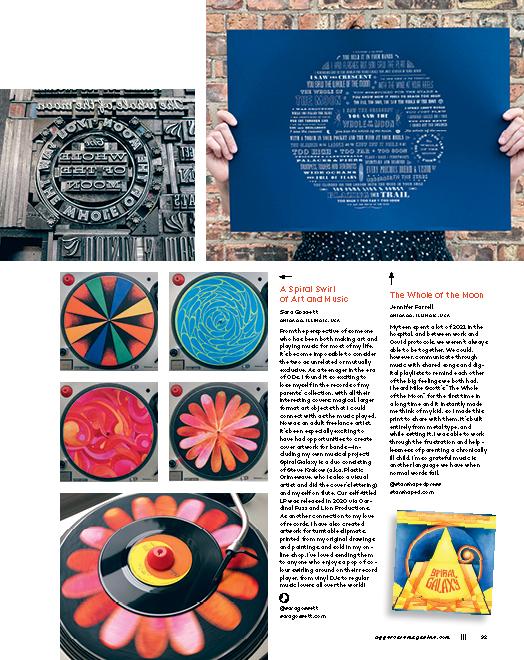


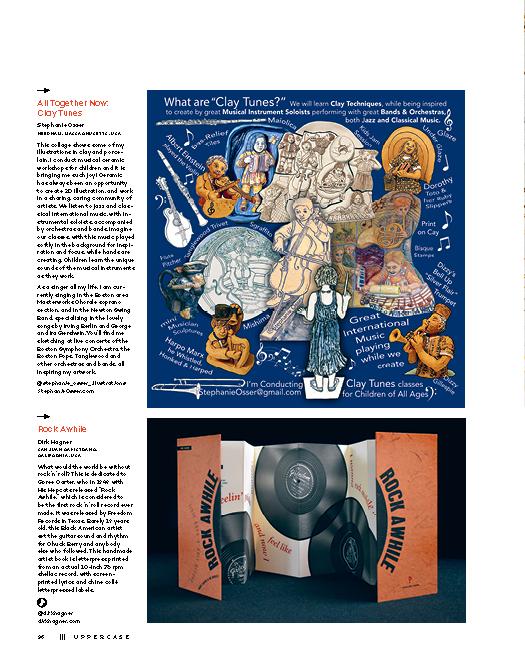
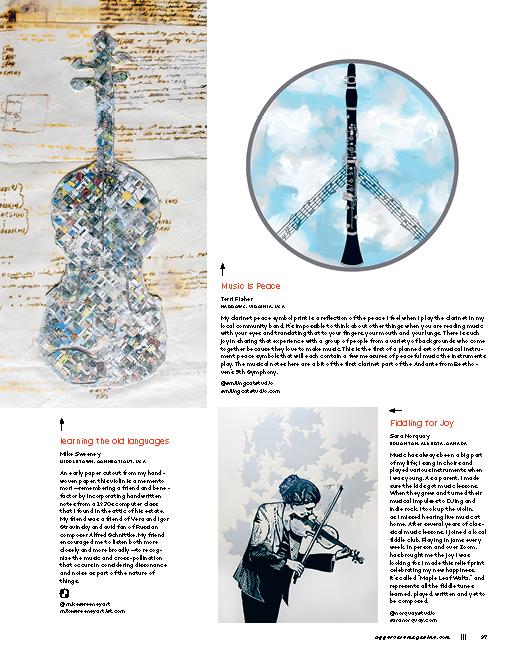










“Device for Listening to Night Falling”
“Silent Picnic”
There is an intimacy unique to audio that Caitlind and Wayne are exploring through this radio show on the local campus station. They are asking how that closeness could open minds and shift perspectives, a question they both are considering in all their projects.
“When we speak of art’s potential to catalyze new understandings of the everyday,” Caitlind says in reference to a phrase from their bio, “we’re talking about what art can do that other aspects of the human-made environment can’t. When we’re working in a public space, we’re often working with architects and designers and civic planners, and they all have relationships with the built environment, and as artists we get to do something that none of those other jobs cover.”

The pieces that Caitlind and Wayne create are collaborative in a number of different ways. Because of the nature of many of their site-specific works, they often think of the first layer of collaboration happening with the physical space itself, the site where the art will live. The next layer of collaboration is with the people who inhabit or visit that space, the folks who will be the viewers of the work. Each piece is created with careful consideration of the community surrounding it.
“We try to have intention and content and concept in the work, but without being too prescriptive of a specific meaning,” says Wayne. “Everyone has their own accumulated experience and so they bring their own perspective to the work. We’ve been surprised in incredibly positive ways by the things people can read in our work, things that we would never see.”
“Collaboration just makes everything more fun, and, honestly, fun is a big part of our work,” Caitlind says. “We’re often thinking about what will be enjoyable—for us and for the viewer—and working with other people is so much more interesting than working alone.”
All of the attention to deep listening that goes into Caitlind and Wayne’s work is also serving the pair as partners. Collaboration as a couple requires next-level communication skills, and these are skills that are constantly being honed by their combined creative practice.
One of their upcoming projects looks directly at communication in a nostalgic and novel way. “Play It by Ear” will be installed in Butler Memorial Park in Edmonton in late 2023, and it will consist of 13 hardwired analogue telephones in various locations throughout the park. When a person picks up one receiver, another phone in the park will ring.



“We’re trying to connect people through these analogue phones,” Wayne says. “It’s super nostalgic to hear those dial tones and the ring tone and the busy signal and the quality of the audio.”
The park is a busy place and frequented by older folks who have longstanding memories of using analogue phones. “We’ve been thinking about how to create conversations between strangers,” Caitlind says. “Maybe the seniors will have a moment of a conversation with someone they wouldn’t have spoken to if they were just walking by them on the street.”
Shaping behaviour, using novelty to surprise and delight folks, and encouraging engagement. These are all outcomes that are made possible through the work of Caitlind and Wayne. “My feeling is that art is about poking holes,” Caitlind says. “You think things are one way, but maybe they’re actually all these other ways.”
uppercasemagazine.com ||| 107
incandescentcloud.com
“Silent Picnic”
“Device for Listening to Night Falling”
“Everyone has their own accumulated experience and so they bring their own perspective to the work.”


I believe in the importance of people— many people, all people—having an intimate relationship with the natural world, and I recognize that it is impossible for many people to gain access to wild places or unaltered landscapes. If nature can only be appreciated in a pristine place, very few among us would have a chance to feel connected to it. With this in mind, I photograph exquisite bits of nature while also capturing audio field recordings. The photos show something lovely, the audio illustrates what is man-made and just beyond the frame. I then layer the visualization of the sound data atop the photo as a digital overlay.
This is an ongoing experimental project that is meant to help me reconcile the perceived need for “peace and quiet” while enjoying nature and the realities of life on a busy planet. This work makes me reflect on the privilege inherent in the opportunities I have had to be completely isolated in nature. It is also meant to help viewers inspect their own relationship to the natural world, and to encourage them to notice all the magic of nature even amidst urban or otherwise altered landscapes.


110 ||| UPPERCASE
clairedibble.com
EXTRA READING

Sounds Wild and Broken: Sonic Marvels, Evolution’s Creativity, and the Crisis of Sensory Extinction
 DAVID GEORGE HASKELL
DAVID GEORGE HASKELL
David George Haskell explores the evolution of the natural marvels of sound and listening: how the creatures of this world (including us humans) came to have song, speech and sonic communication.



An Immense World: How Animal Senses Reveal the Hidden Realms Around Us ED YONG
The sensory existence of humans is extremely limited when compared to the marvels of the animal world. Perhaps if we looked, listened, smelled, tasted and felt beyond our selves, we would be even more motivated to save our world from climate change.

ceramic sounds cecil kemperink
 STORY BY liz logan
STORY BY liz logan
112 ||| UPPERCASE Craft
That’s how Dutch artist Cecil Kemperink describes the sound that emanates from “To Be Continued,” a performance piece in which she pushes and pulls one of her sculptures—made of hundreds of interconnected ceramic rings of different sizes—across a hard floor. The smaller rings tinkle, while the larger rings produce more mellow tones; all along, there is the earthy sound of dry, unglazed ceramic against the stone floor.
When she talks about this piece, Cecil beams through a Zoom call from her studio on Texel, the largest North Sea island in the Netherlands. “I can’t get enough of the sound,” she often says of her pieces. She describes taking the works out of the kiln and hearing them for the first time—the rings are interlocked before firing— as “pure joy.” (Although, sometimes, she says, “it went terribly.”)



Cecil’s sculptures, which are mostly interactive, take weeks to create. She spent decades refining her process—she graduated from art school in 1990—and only just began making a living from her art practice about 10 years ago. Now, she exhibits her work internationally and has found a global audience of collectors. What has always driven her is an obsession with making things, and with ceramic materials.
“I’m a material girl, but not like what Madonna was singing about,” she says with a laugh. “I didn’t start working with clay as my main material until after university. Then, the clay got me, totally, and it didn’t stop. I’m always finding new ways, new possibilities, investigating with the material. I like to investigate. I like not knowing.”
When we spoke, Cecil was preparing to perform “To Be Continued” publicly, as part of Art Month on Ameland, another North Sea island. She will be performing it in a church, twice a day for a week. The sculpture she has created is her largest yet, more than four metres wide. The performance, a meditation on the tide and breathing, will be somewhat improvised, she says, and hopefully the church windows will be open, so the sound of the tide can mingle with the sound of her sculpture.
uppercasemagazine.com ||| 113
“Spectacular.”
CERAMICS
“I’m going to do it frequently, to find out what happens,” she says. “It could take hours. I have to feel it. I’m going to live it and feel it, all the way. I want to show the tide inside. But also, I just want to have fun. Having fun isn’t the only part, but it’s always the most important part.”
It will be her first time performing publicly with one of her sculptures; in the past, she has used models. She was waiting for the right time and place to perform herself; she has been working on her dancing and singing in recent years. Dancing takes her back to her roots. Cecil went to art school because she didn’t get into dance academy after two tries.
“That was my dream, and it collapsed,” she recalls. “But now I dance with my sculptures. So, it all turned out well. Art school wasn’t really a second choice, per se—it was always there. I was always making things as a child. It’s amazing to see, looking back, that I have
gotten to this place. I could not have thought of this. I followed my heart and my instinct and it brought me where I am now.”
In art school, Cecil specialized in textiles, and spent an additional year focused on fashion in particular. A few months after graduation, she began wheel throwing in the studio of a ceramicist she knew. “A couple months later, I had my own wheel, because I couldn’t stop,” she recalls.
Early on, she began cutting rings off the tops of her pots and using those rings in various ways—at first, to decorate plates and bowls. When I ask if she liked the ring as a form, she says, “Yeah,” nodding her head emphatically, her eyes bright. “A circle is the strongest form there is. There’s so much meaning there—continuation, infinity, togetherness, union.”
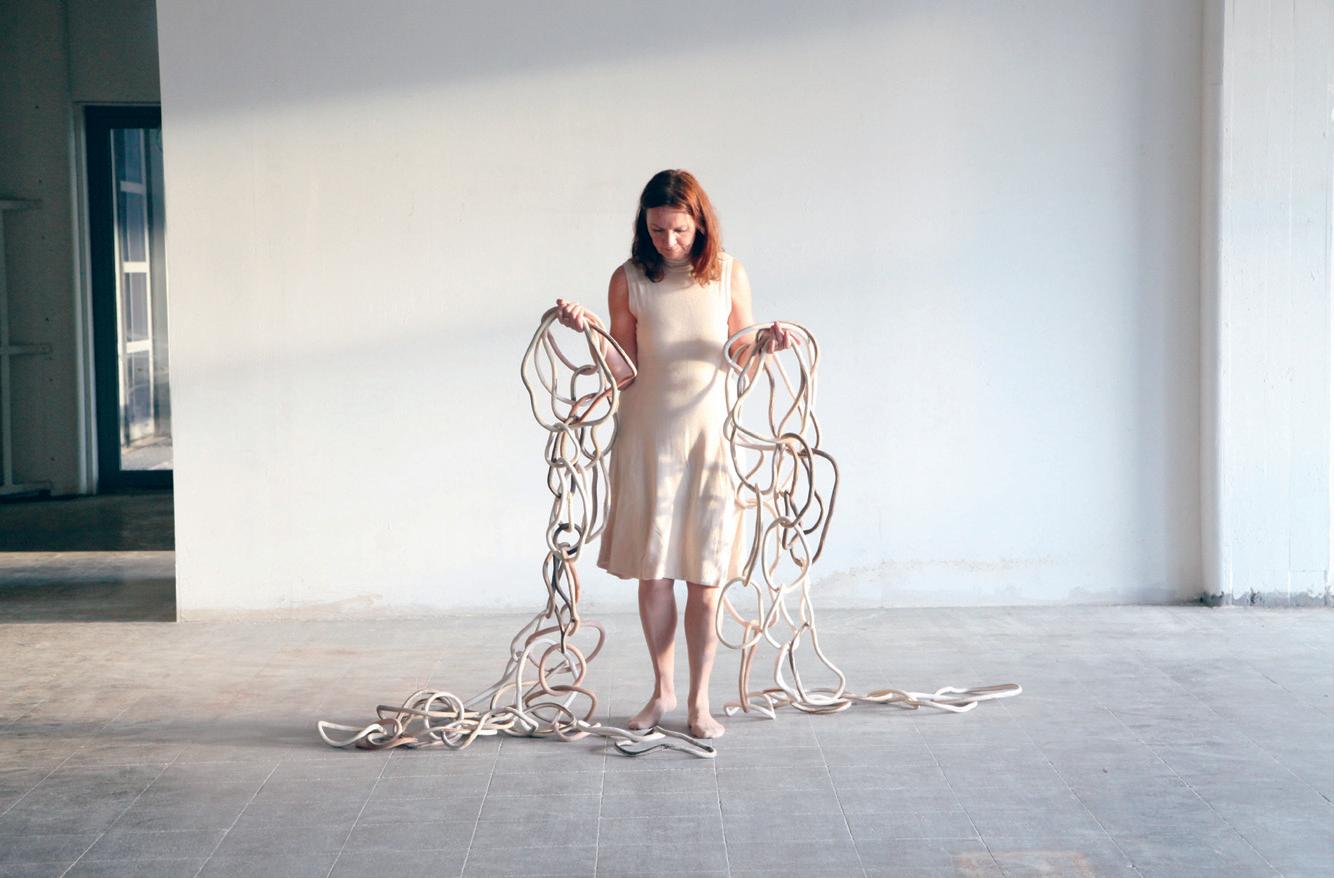
114 ||| UPPERCASE










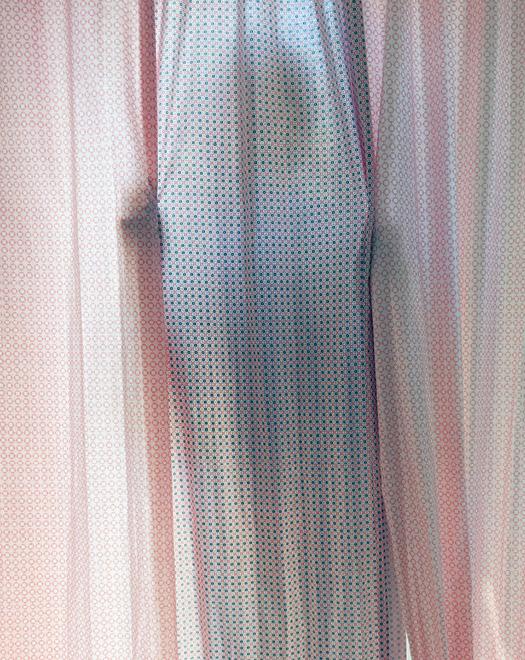

THIS IS A LOW RES PREVIEW OF A HIGH QUALITY QUARTERLY PRINT MAGAZINE PLEASE SUBSCRIBE
subscriber studios
Want to be featured? Submit your studio story!
uppercasemagazine.com/participate
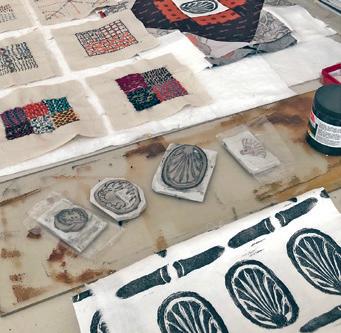 Lela McKee Friel
CALIFORNIA, USA
Lela McKee Friel
CALIFORNIA, USA
WHITETHORN,
I live in the Lost Coast of Northern California, the ocean seven miles from my front door and the wilderness all around me. My last parent passed away this year, leaving a large hole in my life and heart. What comes with this loss is the gift of more time. My studio is my sanctuary and textiles have been in my life since I was a very young girl. After running a small gallery and making space for local artist to have an outlet for their work, as well as my own, I have retired the gallery and now create for the sake of creating, which has also freed me up to donate some of my work to good causes such as the 25 Million Stitches, a project that brings awareness to refugee issues around the world through art, and the Welcome Blanket project, which is another good cause helping refugees. Closer to home, I make donations of my artwork to nonprofits like Hospice and Sanctuary Forest, a place that works in saving surrounding forest land from logging and working with water conservation projects to save our surrounding rivers and streams. I love working with textiles, some commercial and my own, working with my block prints designing fabrics through silkscreen, and making quilts, wall hangings and small items like pincushions and what I call wall art trivets. I like to move around within my work so as not to tie myself down to just one thing. If I need a break from working in a large format I move to the smaller creations that also bring me joy to make. Here is a small view into my studio and some of my work.


126 ||| UPPERCASE
STUDIO
Maureen Fiorellini
WANTAGE, NEW JERSEY, USA
I am a surface pattern designer specializing in creating art for children’s products, and most recently I have become a licensed fabric designer with Studio E Fabrics. Originally from New York, I currently reside in a rural part of New Jersey with my husband, three sons and adorable dog, Pesto.




I have worked as a freelance artist since the birth of my first son, and my studio has evolved over the years. From the kitchen table to an armoire in the living room, to a closet in my guest bedroom, to my bedroom, and now finally I have an entire sunlit room all to myself. I snagged this room when my eldest son went away to college.
I have set up three separate areas in my studio, an area where I can draw and paint, a digital area where I convert all of my art into digital files for manufacture using my beloved iPad and Mac, and a sewing area where I am spending more time lately as I am learning to quilt. One of my favourite features of my studio is a large linen-covered bulletin board my husband made for me, so I can pin up bits and pieces that inspire me or designs that I am working on. This way I don’t forget about them. I also like to “live” with a design for a while before I put it out into the world. What I love about having an entire room is that I can keep unfinished work out, or move from one thing to another if I am feeling stuck, or just want a change of scenery. And I can just close the door when it gets messy—that was so hard when I was working in the other parts of my house. My work tends to be sweet and nature themed. I like to use calm, muted colours, which is a reflection of my easygoing attitude. I am inspired by my love of travel, gardening, nature and family life. My happy life and positive attitude is reflected in my work.
@maureenmaker maureenmaker.com
Volume
Volume E: Ephemera
Volume Q: Quilted These volumes have been out of print for a while. Go to the UPPERCASE website and register your interest for reprints! encyclopediaofinspiration.com
The UPPERCASE Circle is a vibrant community hub, one that is a valuable source of motivation, inspiration and encouragement for like-minded and kind-hearted creative people from around the world. Although the community is initially brought together by its support for and appreciation of UPPERCASE magazine, the Circle will enhance your experience of all things UPPERCASE while providing additional value to your creative life through conversation and the sharing of knowledge.
• Connect with members of the UPPERCASE community— both near and far—who share your interests.

• Share your work with your peers, mentors and potential customers.
• Find inspiration, motivation and new perspectives.
• Move your creative business forward with tips, tools and support from peers and guest experts.
• Live video conferences and video chats.

128 ||| UPPERCASE CIRCLE
for
Access to this community is FREE when you subscribe to UPPERCASE magazine! uppercasecircle.com Circle Make connections, nurture your creative spirit and grow your business! looking forward Be sure to sign up for my weekly newsletter
behind-the-scenes updates and the latest on open calls for submissions.
R: Rag & Pulp UPPERCASE Encyclopedia of Inspiration The eleventh volume in this ongoing series is in the works! It will be about creative papers and papermaking. Planned for release in 2023—show your support by preordering your copy! uppercasemagazine.com/volumeR
UPPERCASE magazine #57 April-May-June 2023 #58 July-August-September 2023 #59 October-November-December 2023 #60 January-February-March 2024 Pitch your article ideas and theme suggestions anytime! uppercasemagazine.com/participate
Volume P: Print/Maker The reprint of Print/Maker is freshly printed! uppercasemagazine.com/printmaker




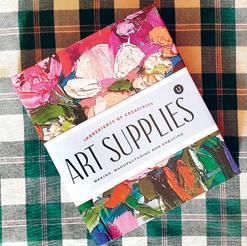
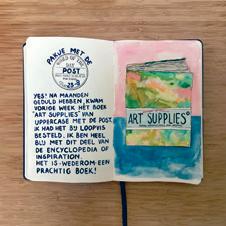
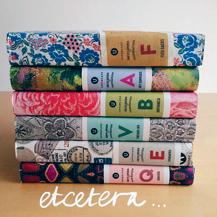




@patchanddot @marilou_scott @dokwaazje @dokwaazje @patchanddot @unblinkstudio @ushadesigns @cookie1949 @curio.lancaster @il_etait_une_fois_dix_doigts SHARES
Please share your pictures and stories of my books, magazines and fabric on Instagram @uppercasemag #uppercaselove with your friends, family and colleagues. It means a lot to me!
music covers
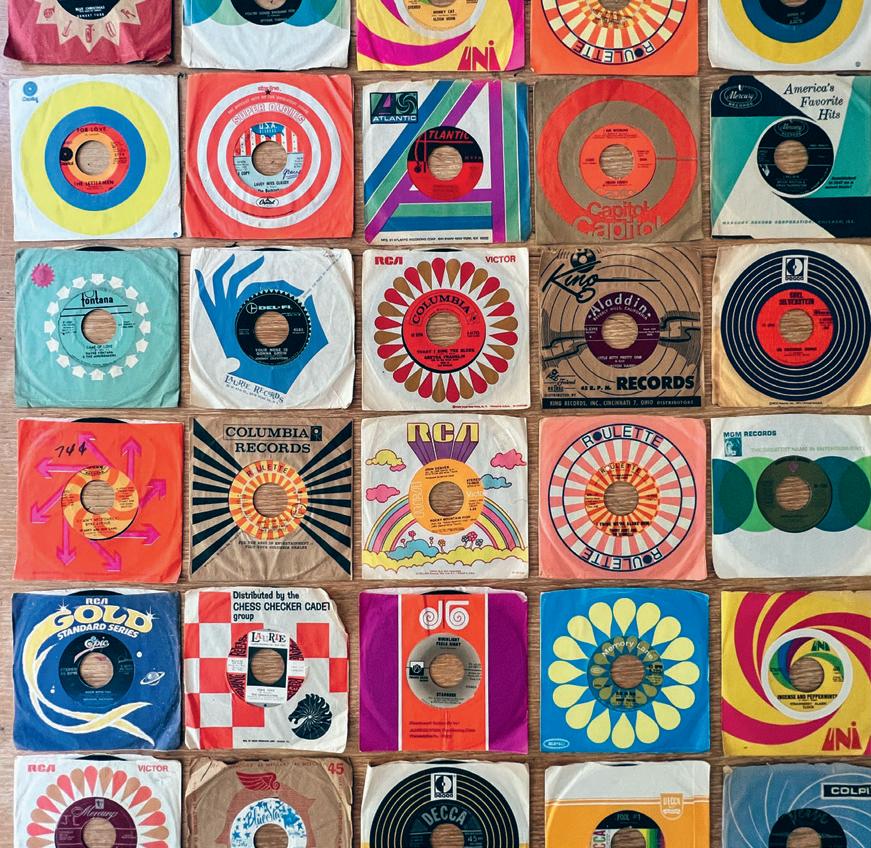 STORY AND PHOTO BY andrea jenkins
STORY AND PHOTO BY andrea jenkins
If living in a postmodern world has taught us anything, it’s that nothing ever really dies. Case in point: longform vinyl records, which are everywhere now. Twenty years ago, we thought for sure they were dead. As digital platforms exploded, we talked longingly about our records in the past tense and waited for them to disappear into the cultural ether like cassette tapes and rotary phones. But a funny thing happened. The people pushed back, demand grew to a respectable (if not deafening) roar and suddenly the industry could not keep up. I knew vinyl had turned a corner when I spotted a generous selection of records displayed next to the mobile phone accessories at a local big box store. Somehow, vinyl had found its way back in. The love for it transcends generations—you are as likely to find Gen Z kids spinning records as you are Boomers, and I, for one, am here for it. What you won’t find on display at big box stores now is the sweet little sibling of the LP vinyl album: the 45 record. Once used to introduce new music to the masses, 45 singles were the promotional workhorse of the industry. And I should know, since I spent the bulk of my precious pre-teen allowance on 45s. I would hear something I liked on the radio, grab my little plastic
coin purse and head straight for the big box bargain store at the edge of town. When I didn’t have money for the full-length album (which was often), the 45 was my way of owning not just a little piece of the music, but a piece of album art as well. This is also how, in the confines of a tiny Midwestern town, I was introduced to musical giants Bowie, Blondie and Prince. Still, it’s not exactly hard to see why 45s didn’t flourish alongside longform vinyl. Digital music platforms offer an endless buffet of music, available for sampling 24/7. Now, the Internet does the work a 45 once did—a few listens to new music online helps us determine what albums are actually worth owning on vinyl (and which perhaps are not). In this way, digital and analogue have formed an unlikely symbiotic relationship of sorts, and who’d have thunk it? A few indie record companies may still produce 45s, but for the most part, the bulk of what is still out there was produced in the past—the first records appearing as early as 1949, with production that continued well into the 1980s before dropping off. Some years ago, I stumbled onto a pile of old 45s in a junk shop. While my interest was initially rooted in prepubescent nostalgia, what really caught my eye were the striking colours and whip-smart designs of the sleeves. For the first time, I was more drawn to the covers than the music itself. I bought my first stack of candy-coloured sleeves for a few dollars, and lo, an obsession was born. While the prices of LP vinyl sales soar and originals become harder and harder to find, the humble 45 continues to fly under the radar and my collection only continues to grow. Each acquisition, a small piece of art, an invaluable sliver of pop culture history. At a flea market in Italy recently, I found a dusty box packed with old 45s, most with cover designs I had never seen before. I could barely contain my excitement as I handed the stack of (mostly empty) sleeves to the dealer. I could see he was confused—he gestured to the empty sleeves and in his broken English (and my broken Italian) we went back and forth until finally, he gave up. Why would I want sleeves without the records? I gave him a few euros for the pile and moved on—the sleeves as good as gold in my hands, a reminder that art lives both in the grooves of the vinyl and on the small paper sleeves that hold them.
130 ||| UPPERCASE COVET
@hulaseventy


$18 CAD/USD PRINTED IN CANADA JANUARY-FEBRUARY-MARCH 2023 uppercasemagazine.com FRONT COVER ali barker BACK COVER felicia dadak 772-0-06863155-56 772-0-06863155-56





























































 ARTICLE BY mark e. sackett AND melanie roller
ARTICLE BY mark e. sackett AND melanie roller


























 BY correy baldwin
BY correy baldwin




















































































 Pamela J. Paulsrud WILMETTE, ILLINOIS, USA
Pamela J. Paulsrud WILMETTE, ILLINOIS, USA























 DAVID GEORGE HASKELL
DAVID GEORGE HASKELL




 STORY BY liz logan
STORY BY liz logan














 Lela McKee Friel
CALIFORNIA, USA
Lela McKee Friel
CALIFORNIA, USA


















 STORY AND PHOTO BY andrea jenkins
STORY AND PHOTO BY andrea jenkins

